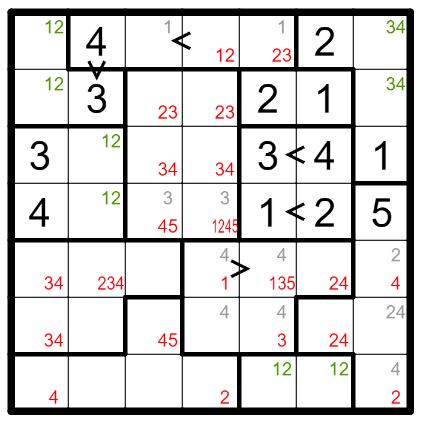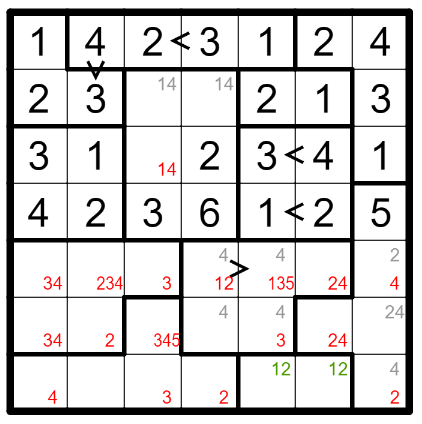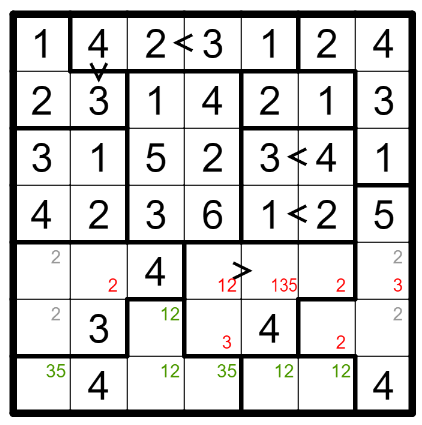This was a very tricky puzzle, but in the end I believe the solved grid should look like this:

In the step-by-step diagrams that follow I have used three different colours in the small pencil marks:
- Red in the bottom-right corner indicates an impossible value;
- Green in the top-right corner indicates the only possible values;
- Grey in the top-right corner indicates all of the spaces within a shape that may take a particular value of interest.
Large black digits are part of the solution.
Step 1:
Some initial pencil-mark deductions:

Predominantly, these are the result of noting that (i) a 1 can never appear at the open end of a '<' sign, and the largest number in any shape can never appear at the closed end, and (ii) a shape of two cells must contain 1 and 2, so immediate inline neighbours cannot contain 2. Furthermore:
- The 4 in column 6 must appear in row 3 or 4;
- R6C3 cannot be 4 or 5, and R6C6 cannot be 5, or it is impossible to place these figures in the two shapes wholly contained by rows 5 and 6;
- No 4 may appear in R3-5C7;
- R1C2 cannot be 3; else, R2C1 must also be 3, and then there is no way to place a 3 in the 2x square in columns 1 and 2.
Step 2:
Assume now for contradiction that R2C6 contains a 2. This soon produces the following state of play by knock-on logical deductions:

(i.e. 2 in R2C6 → 1 in R2C5 → 1 in R4C5 & 2 in R3C5 → 2 in R1C7 & 1 in R1C6 (since cannot be 3 or 4) → 4 in R2C7 & 3 in R3C7 → 4 in R7C7 & 4 in R3C6 & 3 in R4C6)
This means there is now no way to place a 3 in the bottom-right shape, as all its cells are covered by the 3's in R3C7 and R4C6. Contradiction.
Instead, R2C6 contains a 1, and we can make a few further knock-on pencil marks:

R1C6 cannot now be a 3, or there will be nowhere valid for a 3 in the top 1x4 rectangle. Instead, it must contain a 2. This then resolves the 2x2 box below, in the process forcing R1C7 and R2C7 to contain a 3 and 4 between them, which forces R4C7 to be a 5.

Note here that we have also learned some information about the 3's - notably, the top-left corner cannot be a 3, or there is no valid placement for a 3 in the top 1x4 rectangle. This in turn means that no 3 can be in R2C3-4, which forces a 3 to be placed in R4C3-4, which now (as you can see in the diagram above) leaves only one position for a 3 in the left-most 2x2 square: R3C1. Filling this in leads to a few knock-on deductions, including that R1C2 must be a 4 by the inequality, and then R4C1 must also be a 4:

At this point we now realise that R1C3 must be a 2 and R2C7 cannot contain the 4, otherwise there will be no legal space for a 4 in the 2x3 rectangle. Thus, it is a 3. Logical knock-ons end up entirely resolving all 3 of the shapes in the top row:

Step 3:
Now there is only one valid position each for the 2 and 3 in the 2x3 rectangle: R3C4 and R4C3, respectively. Furthermore the bottom-right cell of this shape must contain the 6 - no other number may be placed here. We can now fully resolve the left-most 2x2 box.

There must now be a 3 in R6C2, since no other cell within its shape may contain it. This fixes the position of the 4 within the same shape, which helps fully resolve the 2x3 rectangle (where R3C3 can only be a 5). Further pencil marks can be made:

And now there is only one possible space for the 4 to be placed in the empty shape in rows 5-6: R6C5. We make yet more pencil marks...

Step 4:
Finally, only 2 can now be placed in R5C5. This helps position the 2 in the bottom-right box, and the rest follows!












